Susan Appleyard's Blog, page 19
March 26, 2016
Book Corner: On the Trail of the Yorks by Kristie Dean — History… the interesting bits!
Today is the last day of Kristie Dean‘s Blog Tour to celebrate the release of her latest book, On the Trail of the Yorks. Congratulations to Kristie on what has been a wonderful virtual book tour – and ‘thank you’ for asking History…the Interesting Bits to be a part of it. So, I think, for […]
via Book Corner: On the Trail of the Yorks by Kristie Dean — History… the interesting bits!


March 18, 2016
Death of the young king
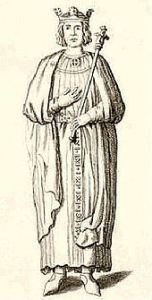 Henry the Young King
Henry the Young KingOf the four sons of Henry II and Eleanor of Aquitaine, Henry the young king was the only one beloved by the people. He had all the requisite attributes to make him a popular figure. He was tall, handsome, charming, and he distributed largesse with a liberal hand even though he seldom had two coins to rub together. He was also a hero of the tourney circuit.
But, as his parents knew, he was also improvident, irresponsible, vain, idle, deceitful, and surrounded himself with sycophants and parasites. Desperate to rule lands of his own, he had led a rebellion against his father and then made war on his brother Richard, who ruled Aquitaine. When that war fizzled out, he wandered aimlessly through southern Aquitaine, picking up mercenaries here and there and robbing shrines to pay them. At Rocamadour, among the valuable objects stolen was the famed Durandel, the sword of Roland.
It was the middle of June. Henry II was still prosecuting the siege of Limoges, which was winding down. Messengers told him the young king was at Martel and gravely ill with dysentery and fever. They said he was unlikely to live and he begged his father to come so he could obtain his forgiveness. Henry didn’t believe them. He was reminded of the crossbow bolt stuck in his cloak and the one that lodged in the shield of his bastard son, the deceit, and the betrayals. Henry knew how it would be: he would arrive to find a miraculous recovery had taken place, and his son would cozen him with tears and smiles and all that boyish charm that he knew how to use to such effect.
The messengers tried to assure him it was no trick, but he sent them away, and his men were relieved that he was not about to walk into a lethal trap.
But was Henry beset by doubts? Was it just his suspicious nature asserting itself? What if his son really was dangerously ill? He must have been tormented by the image of his ill son waiting vainly for him to arrive, dying without the consolation of knowing that he was forgiven and loved even to the end.
At Martel the young king was indeed mortally ill. A physician was found who got a potion into him. His friends, his intimates, watched over him, bathed his face, cleaned him and changed his linen when he soiled himself.
There were lucid periods, and that was when he expressed his agony over his sins and his fear of damnation. He begged his companions to send to his father, whom he had so deeply offended, contrary to the decrees of Heaven itself. A priest attended him. He made a good confession and received Extreme Unction, but it wasn’t enough. At his request, his friends made a bed of ashes and cinders on the floor and laid him upon it. He asked if his father was coming and they assured him he was on his way. He never knew that Henry had refused his dying request because delirium seized his mind as his youthful body rotted from the inside.
King Henry had often been contemptuous of his son’s ne’er-do-well friends, but they had shown themselves true friends. None deserted him. They cared for him tenderly on his sickbed and eased his passing with their love.
When it was over, they took him to Grandmont, the very house from which they had stolen the only object of intrinsic value, Henry’s gift, a gold and jeweled crucifix a few weeks earlier. The monks prepared him for his final rest, said the prayers that would dispose God to deal mercifully with his sins, and awaited the king’s instructions regarding the disposition of the body.
Henry was in a peasant’s cottage beyond the siege lines with some of his intimates when a monk of Grandmont was brought to him. For many years he had had a close relationship with Grandmont, a house dedicated to austerity and poverty, where he wished to be buried. He thought the monk had come to request compensation.
The message the monk brought was that the young king was dead. He was twenty-eight years old.
Perhaps King Henry found some comfort in knowing that his son had faced death courageously and with true repentance. But did he ever forgive himself for not answering that plea?
Henry II and the young king are characters in my book ‘The First Plantagenet.’
Sources: Henry II by W.L. Warren, Wikipedia.


March 11, 2016
Review of Queen of Trial and Sorrow
Reviewed by Sarah Stuart for Readers’ Favorite
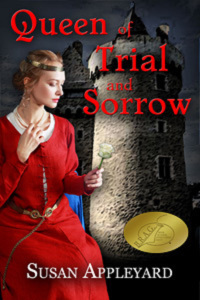
This story is accurately and graphically set against the bitter and bloody battles that comprise the Wars of the Roses, and the tangled politics of a disputed throne. Queen of Trial and Sorrow begins with Susan Appleyard showing Elizabeth Woodville as the placidly contented wife of Sir John Grey. On his death from battle wounds, she returned to her parents, a penniless widow with two boys clinging to her skirts. Her family opposed the upstart King Edward IV but held their peace, awaiting the victorious return of King Henry and Queen Margaret. Elizabeth awoke to true womanhood when the king kissed her hand; the mother of the princes in the tower lived a life full of passion and demanding court ceremony with her beloved Edward until his tragic death, but her lone battles were still to come.
Susan Appleyard captured my attention from Elizabeth Woodville’s opening thoughts in Queen of Trial and Sorrow, and she held it from beginning to end. I have never seen a period, a divided and battling country, or a person, brought to life so skilfully. Elizabeth lives, breathes, thinks, acts, loves, and hates with a vividness that it would be difficult to surpass. For devotees of historical novels, this is a must-read, but what of those who enjoy a sizzling romance? Young, handsome King Edward was a womaniser and Elizabeth held out for three years when he offered only a wanton liaison. So, what then? “Give me a kiss, sweetheart, and I’ll give you a crown.”


February 29, 2016
Henry II and his sons
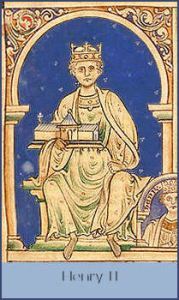 Henry II
Henry IIAs noted in my previous post, in the Great War, Henry II had thoroughly trounced his three sons, Young Henry, Richard and Geoffrey, but they were far from cowed. Richard was the ruler of Aquitaine, Geoffrey was Duke of Brittany and Young Henry was King of England, but since his father was still alive and bore that title, he didn’t have anything to rule. This lack led him into an improvident and irresponsible lifestyle, and bitter jealousy of his younger brothers.
A decade later, Young Henry and Richard quarreled over possession of the castle of Mirabeau, and the older Henry summoned them to join him in Le Mans in order to repair the situation before it got out of hand. Henry II was a wise ruler and an intelligent man, but, blind where his sons were concerned, he was inclined to indulge rather than punish and put his trust in them even when he must have known they were deceiving him. First he persuaded Richard to hand over the castle of Mirabeau to himself, which Richard was initially unwilling to do, and then he required his two younger sons to take oaths of homage to the elder as heir to the overlordship of the Angevin federation. Richard refused. He argued that he did not hold any lands within the young king’s perceived inheritance; Aquitaine came to him through his mother Eleanor, and he did homage to the King of France. His refusal infuriated the old king and another quarrel ensued. Without leave from his father, Richard quit the court and rode in haste to his own territory to fortify his towns and castles.
 Henry the Young King
Henry the Young KingNow the young king’s skill in duplicity came to the fore, at the same time as the old king’s blind trust reached new heights. Young Henry sought his father’s permission to go to Aquitaine and bring to terms the rebellious barons Richard had been unable to quell. Henry II agreed, even though he must have known the only reason Young Henry might succeed where Richard had failed was because a secret understanding had existed for a few years, Young Henry having convinced the barons that he would be a more sympathetic lord than Richard.
So it transpired. Young Henry sent his wife off to her brother in Paris, and as soon as he reached Limoges he secretly accepted the service of Richard’s disaffected barons. Henry II followed behind with only a small escort, but when he approached the city gates, a shower of arrows rained down on him and his men, one of which pierced his cloak. The king withdrew and attempts at negotiation followed, with Young Henry claiming it was a misunderstanding and his father – at least on the face of it – believing him. (It must have been hard for Henry to accept that his beloved son had tried to kill him.) The negotiators met with abuse, and arrows flew again when the king approached the town a second time. Meanwhile, since Richard had demolished the walls of Limoges, the rebels were frantically tearing down churches and throwing up ramparts.
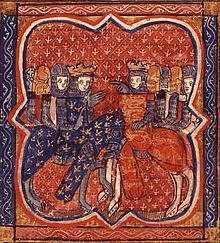 Richard and Philip of France
Richard and Philip of FranceThe rebels of Aquitaine had already tasted Richard’s mettle, and Henry II was a renowned and successful commander of armies. Apart from his household knights, Young Henry had few men with him, nor did his allies, so they were in desperate straits. But now Geoffrey entered the fray. He had the resources of Brittany with which to hire mercenaries, giving the rebels a fighting chance. At the same time Count Aymer of Limoges summoned mercenaries from the wilds of Gascony, and King Philip of France sent more to to aid his brother-in-law, Young Henry. Finally the king was forced to face the truth, and he immediately sent for mercenaries of his own.
Richard was savagely dealing with the disorder created by hordes of undisciplined mercenaries, moving swift as a cat from one part of the province to another, while the king laid siege to Limoges. As his own, more disciplined mercenaries began to arrive, the position of Young Henry and the rebels looked more and more precarious. He slipped out of Limoges, after robbing the citizens and plundering the shrine of St. Martial to pay his mercenaries. When he tried to return, his famous charm failed to overcome the anger of the townsfolk, who pelted him with stones from the walls.
Rootless and purposeless, he drifted through southern Aquitaine, until he developed dysentery, and died.
These events are portrayed in my book The First Plantagenet.
Sources: Henry II by W.L. Warren & Wikipedia
http://www.amazon.com/First-Plantagenet-Susan-Appleyard-ebook/dp/B01AXC7HB4/
http://www.amazon.co.uk/First-Plantagenet-Susan-Appleyard-ebook/dp/B01AXC7HB4/


February 22, 2016
Royalist Rebel by Anita Seymour.
I recently had the pleasure of reading Anita Seymour’s civil war story about the fascinating Elizabeth Murray. Here is the review I posted on Amazon.
The aristocratic Elizabeth Murray is a staunch royalist during the civil war between Charles I and the parliamentarians. Ms. Seymour pulls no punches in painting her as a woman of her times. She is strong, haughty, intelligent, uncompromising and with a great deal of charm when she chooses to use it, such as on people who can be of use to her. Her father is in the service of the king and often away from home. It falls to Elizabeth to care for her three younger sisters, while couragously safeguarding her birthright, Ham House, from the parliament men who are sequestering prime royalist properties. When faced with no other choice, she wisely submits to having rude and crude soldiers billeted at Ham House. Marriage to a baronet and a wary friendship with ‘Old Ironside’ relieve some of the pressure on her.
Among the lesser characters, we meet the doomed Charles I and his charming son, the handsome, flamboyant Prince Rupert, and one of my most hated historical characters, Oliver Cromwell, who Ms. Seymour depicts with sympathy.
The portrayal of those cruel and turbulent times is flawless. Elizabeth and the other characters are brought brightly to life. This is a very book and an easy read.
http://www.amazon.com/Royalist-Rebel-Anita-Seymour-ebook/dp/


February 14, 2016
The First Plantagenet
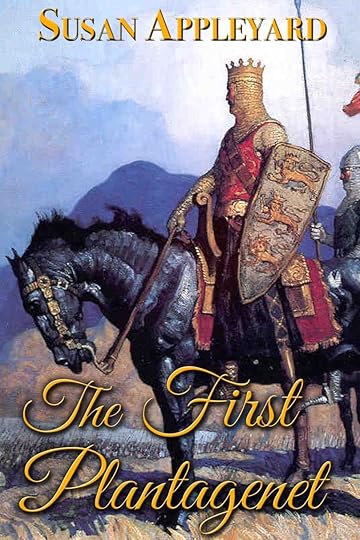 Here is my latest book.
Here is my latest book.
Available from Amazon.
http://www.amazon.com/First-Plantagenet-Susan-Appleyard-ebook/dp/B01AXC7HB4/


February 12, 2016
Henry and Eleanor
 Henry II
Henry IIHenry II was born at Le Mans, Maine, on March 5th 1133, the eldest son of Geoffrey Count of Anjou and Matilda, daughter of Henry I of England and widow of Emperor Henry IV of Germany. Geoffrey was given the surname Plantagenet because of his habit of riding through his domains with a sprig of the Broom Plant, Planta Genesta, stuck in his cap.
Red-haired, stocky, with a thick neck, often scruffily dressed, Henry was neither as handsome and charming as his father, nor as reserved as his mother. He was energetic, able, intelligent, well-educated and given to infantile fits of temper. He became one of England’s most effective kings.
At the age of nineteen, he was Duke of Normandy and Count of Anjou and Maine. When he married Eleanor of Aquitaine he also became Duke of Aquitaine. His crowning as King of England at the age of 21 ended the civil war that chroniclers called ‘the nineteen years when Christ and the Saints slept’ and others called ‘the Anarchy’.
Henry curbed the power of the barons and strengthened the authority of the Crown. He reformed the law and the law courts by establishing Royal Magistrate courts in place of baronial courts, empowered the exchequer to deal with property disputes – of which there were plenty in the wake of the civil war – and instituted Common Law in place of such practices as trial by combat and trial by ordeal. He also streamlined the techniques of administration. Often embroiled in war because his form of government ran contrary to those who profited from their independence, Henry was only as cruel as he needed to be. Rather than lopping off heads, he fined or confiscated or, in extreme cases, imprisoned. Even the most unrepentant rebel usually found his property reinstated after a short time.
As a ruler he was a genius. As a father and husband he was a good deal less successful.
Following the tradition of the French kings, Henry had his son and heir crowned in his lifetime. Young Henry was only fifteen at the time and no doubt he enjoyed wearing a crown and lording it over his younger brothers, but he wanted some of the power that went along with his new status. His father, perceiving qualities in the boy that were not to his liking, refused to share power with him. Similarly, Richard, who was Eleanor’s heir in Aquitaine, and Geoffrey Duke of Brittany in right of his wife, were not allowed to rule independently of the officers Henry set over them.
All three boys were still in their teens when they rebelled against their father in May 1173. The war was known as the Great Revolt. King Louis of France was Young Henry’s father-in-law and no doubt stirred up a poisonous brew for those youngsters to devour. In support of the Young King were King William of Scotland, the counts of Boulogne, Flanders and Blois. In England four earls, all with axes to grind, joined the rebellion. In fact, there were rebels in all Henry’s vast territories with the exception of Normandy. The situation was serious enough to undermine Henry’s authority and disrupt his government.
Most of the rebels were malcontents who refused to be reconciled to Henry’s rule and no doubt he could have predicted who they were. But there was one whose inclusion among the rebels must have come as a vast shock : his wife, Eleanor.
During Henry’s reign, Eleanor, Duchess of Aquitaine in her own right and ex-Queen of France, had become something of a nonentity. In the hope of gaining back some of the power she had lost through her marriage, she joined her sons. She was apprehended by her husband’s men as she rode to Paris to join her sons disguised as a man.
Because the revolt was so widespread there were several campaigns, but Henry focused his attention on Normandy and then on England, overcoming his enemies piecemeal. By August of the following year he had triumphed on all fronts. As usual he was magnanimous in victory. The barons and their liegemen who fought against him were permitted to receive possession of lands they held fifteen days before his sons rebelled. Two English earls were imprisoned for two years but then had their lands restored to them. King William paid a high price for backing the losers. He became the liegeman of Henry for all his lands and was required to perform an act of submission at York. The three sons were not only forgiven but rewarded. Henry assigned revenues to all.
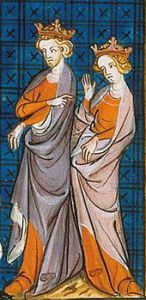 Henry & Eleanor
Henry & EleanorAs for Eleanor, there was no forgiveness for her. The wound she had inflicted cut the deepest. She remained Henry’s prisoner for the rest of his life, with due comfort and courtesy. In later years she was allowed greater freedom and from time to time Henry permitted her to see their sons.
This was not the only war Henry fought against his sons. The later ones were to have tragic consequences.
Henry II is the main character in my new book The First Plantagenet.
See it here: http://www.amazon.com/First-Plantagenet-Susan-Appleyard-ebook/dp/B01AXC7HB4/
The first Plantagenet
 Henry II
Henry IIHenry II was born at Le Mans, Maine, on March 5th 1133, the eldest son of Geoffrey Count of Anjou and Matilda, daughter of Henry I of England and widow of Emperor Henry IV of Germany. Geoffrey was given the surname Plantagenet because of his habit of riding through his domains with a sprig of the Broom Plant, Planta Genesta, stuck in his cap.
Red-haired, stocky, with a thick neck, often scruffily dressed, Henry was neither as handsome and charming as his father, nor as reserved as his mother. He was energetic, able, intelligent, well-educated and given to infantile fits of temper. He became one of England’s most effective kings.
At the age of nineteen, he was Duke of Normandy and Count of Anjou and Maine. When he married Eleanor of Aquitaine he also became Duke of Aquitaine. His crowning as King of England at the age of 21 ended the civil war that chroniclers called ‘the nineteen years when Christ and the Saints slept’ and others called ‘the Anarchy’.
Henry curbed the power of the barons and strengthened the authority of the Crown. He reformed the law and the law courts by establishing Royal Magistrate courts in place of baronial courts, empowered the exchequer to deal with property disputes – of which there were plenty in the wake of the civil war – and instituted Common Law in place of such practices as trial by combat and trial by ordeal. He also streamlined the techniques of administration. Often embroiled in war because his form of government ran contrary to those who profited from their independence, Henry was only as cruel as he needed to be. Rather than lopping off heads, he fined or confiscated or, in extreme cases, imprisoned. Even the most unrepentant rebel usually found his property reinstated after a short time.
As a ruler he was a genius. As a father and husband he was a good deal less successful.
Following the tradition of the French kings, Henry had his son and heir crowned in his lifetime. Young Henry was only fifteen at the time and no doubt he enjoyed wearing a crown and lording it over his younger brothers, but he wanted some of the power that went along with his new status. His father, perceiving qualities in the boy that were not to his liking, refused to share power with him. Similarly, Richard, who was Eleanor’s heir in Aquitaine, and Geoffrey Duke of Brittany in right of his wife, were not allowed to rule independently of the officers Henry set over them.
All three boys were still in their teens when they rebelled against their father in May 1173. The war was known as the Great Revolt. King Louis of France was Young Henry’s father-in-law and no doubt stirred up a poisonous brew for those youngsters to devour. In support of the Young King were King William of Scotland, the counts of Boulogne, Flanders and Blois. In England four earls, all with axes to grind, joined the rebellion. In fact, there were rebels in all Henry’s vast territories with the exception of Normandy. The situation was serious enough to undermine Henry’s authority and disrupt his government.
Most of the rebels were malcontents who refused to be reconciled to Henry’s rule and no doubt he could have predicted who they were. But there was one whose inclusion among the rebels must have come as a vast shock : his wife, Eleanor.
During Henry’s reign, Eleanor, Duchess of Aquitaine in her own right and ex-Queen of France, had become something of a nonentity. In the hope of gaining back some of the power she had lost through her marriage, she joined her sons. She was apprehended by her husband’s men as she rode to Paris to join her sons disguised as a man.
Because the revolt was so widespread there were several campaigns, but Henry focused his attention on Normandy and then on England, overcoming his enemies piecemeal. By August of the following year he had triumphed on all fronts. As usual he was magnanimous in victory. The barons and their liegemen who fought against him were permitted to receive possession of lands they held fifteen days before his sons rebelled. Two English earls were imprisoned for two years but then had their lands restored to them. King William paid a high price for backing the losers. He became the liegeman of Henry for all his lands and was required to perform an act of submission at York. The three sons were not only forgiven but rewarded. Henry assigned revenues to all.
 Henry & Eleanor
Henry & EleanorAs for Eleanor, there was no forgiveness for her. The wound she had inflicted cut the deepest. She remained Henry’s prisoner for the rest of his life, with due comfort and courtesy. In later years she was allowed greater freedom and from time to time Henry permitted her to see their sons.
This was not the only war Henry fought against his sons. The later ones were to have tragic consequences.
Henry II is the main character in my new book The First Plantagenet.
See it here: http://www.amazon.com/First-Plantagenet-Susan-Appleyard-ebook/dp/B01AXC7HB4/
January 5, 2016
Yet another who should have been king…
Except that if you want to succeed your father it pays to be nice to him. Especially when that father is William the conqueror.
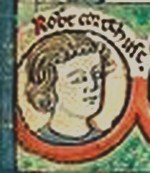 Robert Curthose
Robert CurthoseBorn in 1061, Robert was the eldest son of William and Matilda of Flanders. He was nicknamed Curthose because of his short legs.
Robert’s first rebellion occurred when his younger brothers dumped a full chamberpot over his head. A scrap between the siblings ensued, which William had to break up. When he failed to punish the rapscallions, Robert was even further incensed – and who can blame him? Robert and his followers attempted to seize the castle of Rouen. They failed and were forced to flee to Flanders. That put an end to any hope of a close father/son relationship.
After a failed reconciliation arranged by his mother, Robert took to the life of a knight errant, traveling throughout Europe and siring a number of illegitimate children.
On his deathbed in 1087, the elder William was tempted to disinherit his eldest son, but was persuaded by his nobles to divide the Norman lands, Robert to have Normandy and William Rufus to have England. The nobles in fact preferred Robert, as he was judged the weaker of the two, more easily manipulated and defied.
The two brothers agreed to become each other’s heir. This pact lasted only a year before the nobles persuaded Robert that if there was any justice under the sun he would be King of England. The rebellion came to nothing because Robert didn’t even arrive to support the rebels. Still, the seed had been planted.
In 1096 an impoverished Robert left for the Holy Land. In order to raise money for the crusade he mortgaged his lands to William Rufus for 10,000 marks. When William died in 1100, Robert was on his way back. But younger brother Henry was already in England and able to seize the crown. That didn’t stop Robert claiming the crown for his own, based on the agreement he had made with his brother William.
Robert invaded, but he seems to have been a poor general. Henry repulsed him, forced him to renounce his claim and sent him back to Normandy, where he continued to agitate. Four years later, Henry was prompted by the continual discord between himself and his brother, as well as the unrest in Normandy, to invade. Henry decisively defeated Robert’s forces at the battle of Tinchebrai and claimed Normandy for the English Crown.
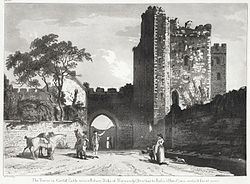 The tower in Cardiff where Robert was held prisoner.
The tower in Cardiff where Robert was held prisoner.Robert was held prisoner by his brother for twenty-eight years and died when he was in his early eighties. He was buried in the abbey church of St. Peter in Gloucester, now Gloucester Cathedral. His effigy carved in bog oak and lying on a mortuary chest can be seen there.
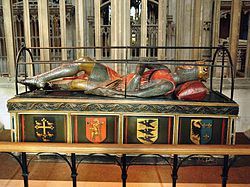 Mortuary chest
Mortuary chest

December 16, 2015
BRAG Medallion
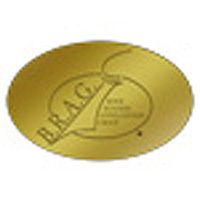 Brag Medallion
Brag MedallionI’m thrilled to announce that my book, Queen of Trial and Sorrow, has been awarded a B.R.A.G. Medallion. (That’s an acronym for Book Reader’s Appreciation Group.)








